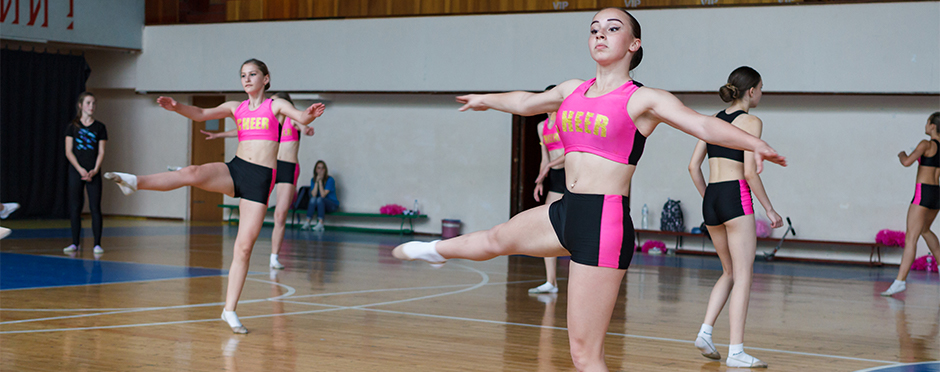
Cheerleading Safety Tips
Leave a CommentCheerleading is a potentially high risk sport and it involves extensive and consistent training.
Participation in cheerleading ranges from young kids through collegiate athletes. The National Federation of State High School Associations (NFHS) estimates approximately 400,000 students participate in U.S. high school cheerleading annually, including competitive squads.1 Cheerleaders can be found at the elementary, junior high, high school, and collegiate levels as well as at park districts or private competitive gyms. Cheerleading squads can be all-girl or co-ed.
Who Gets Injured Most in Cheerleading
The overall injury rate in cheerleading is lower than in other high school girls sports.2 Similar to most sports, cheerleading injury rates increase with age and competition level, with collegiate cheerleaders having the highest rates overall.2 The overall most common injury mechanism in cheerleading was found to be contact with another person and contact with the playing surface.1 The activities with the most injuries include stunts, tumbling and pyramids.1
Research shows that bases or spotters may have higher rates of injury compared to flyers.1,3 Bases typically have to lift, catch or toss other athletes, plus they also have the risk of a person landing on top of them or having a knee or elbow hit them as they try to catch the flyer contributing to their increased injury rate.
What are the Most Common Cheerleading Injuries 1, 2, 3
- Lower extremity injuries are more common than upper extremity injuries
- Sprains – including the ankle, knee and wrist
- Strains – especially to muscles in the back
- Sprains and strains combined make up approximately 53 percent of injuries2
- Fractures (10-16 percent of injuries reported)2
- Concussions (3-5 percent of injuries reported)2
Tips to Prevent Injuries During Cheerleading
- Practice in a space with limited distractions and plenty of room (both horizontally and vertically)
- Use spotters during stunts
- Place mats on the floor
- Be alert to tripping hazards or slippery ground
- Select teammates with the same level of experience
- Always warm up and cool down
- Strengthen the core to protect the back
- Wear proper shoes that support the feet and ankles
- Practice proper landings
- Pay attention to the number of repetitions and run-throughs to avoid overuse and excessive fatigue, which can lead to increased injury risk
- Follow all the rules as laid out by the NFHS and American Association of Cheerleading Coaches and Advisors (AACCA)
Tips for Returning to Cheerleading after Quarantine
- Home workouts may have kept you in shape, but possibly not in full “cheer” shape
- Adjust your return to cheerleading accordingly by paying attention to number of reps for tumbling and stunts
- Plan to focus on flexibility, fitness endurance and the basics at first
- Know the difference between muscle soreness vs injury
- Soreness is normal with a return to full activities but it should only last 1-2 days after training.
- Overuse injuries gradually build and begin to affect your ability to practice as well as outside of practice.
- Plan to return gradually to assess your body’s reaction to your sport again. Progressing too quickly can lead to more risk of injury.
If you are concerned about an injury from cheerleading, visit your closest Athletico clinic for a free assessment. Assessments are available in-clinic and virtually through our Telehealth platform.
The Athletico blog is an educational resource written by Athletico employees. Athletico bloggers are licensed professionals who abide by the code of ethics outlined by their respective professional associations. The content published in blog posts represents the opinion of the individual author based on their expertise and experience. The content provided in this blog is for informational purposes only, does not constitute medical advice and should not be relied on for making personal health decisions.
References:
1. Currie DW, Fields SK, Patterson MJ, Comstock RD. Cheerleading Injuries in United States High Schools. Pediatrics. 2016;137(1)
2. Labella CR, Mjaanes J. Cheerleading injuries: epidemiology and recommendations for prevention. Pediatrics. 2012;130(5):966-71.
3. Shields BJ, Fernandez SA, Smith GA. Epidemiology of cheerleading stunt-related injuries in the United States. J Athl Train. 2009;44(6):586-94.
